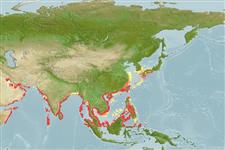Classification / Names
Common names from other countries
Main reference
Size / Weight / Age
Max length : 22.0 cm TL male/unsexed; (Ref. 3259); common length : 15.0 cm SL male/unsexed; (Ref. 188)
Environment
Marine; freshwater; brackish; pelagic-neritic; anadromous (Ref. 51243); depth range 0 - 30 m (Ref. 6898)
Climate / Range
Tropical, preferred 25°C (Ref. 107945); 38°N - 1°N, 47°E - 136°E (Ref. 188)
Distribution
Indo-West Pacific: Gulf of Aden north to the Persian Gulf, then eastward to the Andaman Sea, South China Sea and the Philippines, and north to southern tip of Korea. Single record from South Africa (Ref. 3259).
Countries | FAO areas | Ecosystems | Occurrences | Introductions
Short description
Dorsal
spines
(total): 0;
Dorsal
soft rays
(total): 15-19;
Anal
spines: 0;
Anal
soft rays: 17 - 26. Dark bluish dorsally, silvery below (Ref. 3259). A dark spot behind gill opening. Belly with 17 to 20 (usually 18) + 9 to 13 (usually 11), total 28 to 32 (usually 30) scutes. Anterior arm of pre-operculum with the third infra-orbital bone immediately above it, no fleshy gap between; lower jaw strongly flared outward. Pectoral axillary scale present; hind edge of scales distinctly toothed.
IUCN Red List Status (Ref. 115185)
Threat to humans
Harmless
Human uses
Fisheries: minor commercial
More information
ReferencesAquacultureAquaculture profileStrainsGeneticsAllele frequenciesHeritabilityDiseasesProcessingMass conversion
Tools
Special reports
Download XML
Internet sources
Estimates of some properties based on models
Phylogenetic diversity index
PD50 = 0.5005 many relatives (e.g. carps) 0.5 - 2.0 few relatives (e.g. lungfishes)
Trophic Level
2.2 ±0.09 se; Based on food items.
Resilience
High, minimum population doubling time less than 15 months (Preliminary K or Fecundity.)
Vulnerability
Low vulnerability (21 of 100)
Price category
